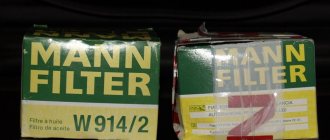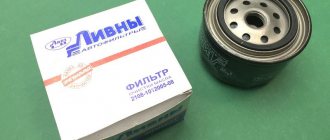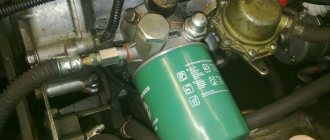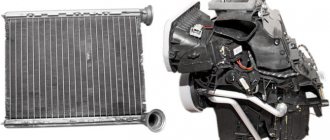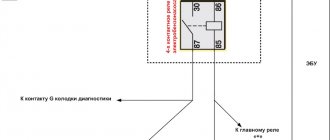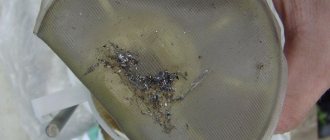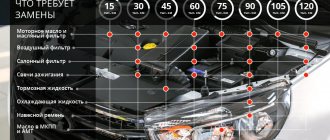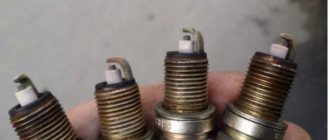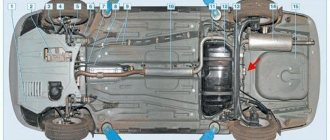The oil filter for a car is an important element of the engine compartment. Cleaning the motor fluid from contaminants that reduce the quality of the fluid from impurities is what an oil filter does. Lada Vesta allows you to fill a wide range of oils into the engine, and the operation of the entire engine and its individual components depends on how successfully it copes with the task. The oil filter for the Lada Vesta car, which is installed at the factory - with the catalog number (article) AvtoVAZ 2105-1012005-82, is good, but car enthusiasts try to replace it at the first opportunity - stereotypes that foreign parts are better - this is not always the case. The car uses a brand filter: Livny, BIG GB-102M, BOSCH 0 451 103 274, Mann, models are suitable for all VAZ cars. Read the article to the end and you will find out: the article number of the Lada Vesta oil filter, how it works, what it consists of and when to change it. Necessary consumables for replacement, brand of filter that is installed on the Lada Vesta, tools for work.
Design and principle of operation of the part
Sample engines that are used in modern car models include a lot of mechanisms rubbing against each other. Operating in this extreme mode, the mechanisms require high-quality lubricant as motor oil. For the rational operation of the engine and its components, the use of high-quality oil filters and timely replenishment of the oil reservoir with the missing amount of liquid are required.
In order for the car to remain operational for a long time, it is necessary to monitor the condition of the spare part and the level of engine oil. Manufacturers of car parts for Vesta and other models offer a wide range of filters. They may look different, but the products do the same job, they have a single mechanism of action. The part cleans the lubricant, removes dirt and metal particles from engine parts and prevents them from getting back into the operating mechanism.
The filter component of the Lada Vesta car is visually similar to filters of other brands - it looks like a dark glass with a cleaning device in the middle. Despite its apparent simplicity, the part has a complex design.
Change of oil
It is better to change the lubricant when the engine is warm - liquid hot oil drains faster and with almost no residue.
The car must be lifted with a car lift (after opening the hood and removing the cap from the oil filler neck) or installed on an overpass or installation pit.
The configuration of the crankcase protection provides access to the drain neck to drain the old oil, but replacing the oil filter is not possible, so the protection must be removed by unscrewing the 13 bolts that secure it to the housing with a 10mm wrench.
It is better to put the bolts in a can of gasoline for cleaning and subsequent lubrication before installing them in place.
After completely dismantling the protection, you need to unscrew the drain plug with an 8-point hexagon, but not immediately all the way - the last couple of turns are done by lifting the container for old oil to it so that the stream does not go past.
The Lada Vesta with a robotic transmission has a drain plug of a different size, and the crankcase has a different design.
During the last turns of the plug, when removing it, precautions must be taken to avoid getting burned by the hot oil jet.
Having installed the tub on the floor in place, they begin to remove the old oil filter. Next to the filter there is a crankshaft sensor, which, in order to avoid damage when removing the filter, must be removed with a 10mm spanner, having first disconnected the plug with the wiring from it.
After removing the crankshaft sensor, they begin to remove the old oil filter - tighten it with a puller chain and make a half turn counterclockwise to unscrew it, after which the part is rotated by hand without effort.
If a puller is not found, then the filter is simply pierced through with a screwdriver, which is then used as a lever for rotation. By this time, the oil from the crankcase should be drained, and the container should be placed under the oil filter.
When removing the oil filter with a screwdriver, it must be pierced in the upper part so as not to damage the threads of the engine fitting.
After removing the old filter, they also give time for the oil to drain and begin installing the new one. The threads on the cylinder block pipe are cleaned with a rag, the new filter is filled approximately 50% with clean oil and the rubber sealing gasket is lubricated with it. The new filter is screwed until the rubber gasket contacts the block, after which the part is turned another ¾ of a turn manually, without using tools, the crankshaft sensor is installed and the wiring plug is connected to it.
The oil plug and the vulcanized washer on it are inspected for damage, if necessary, replaced with a new one or thoroughly cleaned of dirt, especially the threaded part, and then screwed tightly into the socket.
New motor oil in the required quantity is poured into the engine through the oil intake neck from above in portions, which is given time to drain into the crankcase, and its level is measured using a dipstick - to the upper edge of the corrugated part of the measuring section.
Then, closing the oil intake neck with a lid, start the engine, making sure that after 1-2 seconds the oil pressure warning lamp on the instrument panel goes out. After 2-3 minutes of idling, turn off the engine and after 5-10 minutes check the level on the dipstick. If the oil is less than the upper edge of the grooved zone, it is added. If the level is exceeded, then it needs to be lowered to normal - this can be done with a 20-gram syringe with a flexible tube from a medical dropper through the hole in the probe block.
Measurements of the engine oil level should be made while the vehicle is parked on a flat, horizontal platform, the slope of which should not exceed 2 degrees.
The operation is completed by installing the crankcase protection in place on bolts that have been cleaned and lubricated with lithol.
Components
- Glass-shaped shell;
- Filter device in the middle. It is made of a kind of thick cardboard. It is folded a large number of times into an accordion and rolled into a “roll”. The material is treated with an absorbent substance;
- Spring;
- Two valves: bypass, non-return;
- Several entrances and one exit from the opposite side;
- Sealing material on top that prevents liquid from spilling.
Car owners should note that if one component of the filter element breaks down, the entire part must be replaced. Its further operation is impossible.
When to change the oil filter on a Lada Vesta
The oil cleaning element is designed in such a way that even if it is unusable, it does not indicate the need for replacement. Lubricant enters the engine. Filled with waste materials, it does not cope with its functions. The filter element does not clean the oil; it, along with all the impurities, enters the car engine; the deteriorated lubricating properties of the oil do not adversely affect its performance.
Owners are required to periodically inspect in detail for contamination. To do this, you need to remove it and visually assess the degree of cleanliness.
AvtoVAZ recommends inspecting and replacing the part on the Lada Vesta within the following periods:
Carrying out primary service requires mandatory replacement of the part along with the oil. Further replacement occurs every 14,000 - 28,000 kilometers traveled. However, if you take into account the quality of the road surface on which the car is driven and the driving style, it is better to replace it every 6,000 - 15,000 kilometers. Visually assess the amount of accumulated debris and pollution every 3,000 - 5,000 kilometers. Mechanics recommend listening to the car’s operation; if certain signs appear, be sure to inspect the Lada Vesta filter for leaks.
Replacing Lada Vesta filters
Replacing Lada Vesta filters is an important procedure that is part of vehicle maintenance. Timely replacement, use of high-quality consumables (filters) and work done correctly are the key to trouble-free operation of the car.
That is why it is important not only to change parts on the car in a timely manner, but also to use only suitable parts of good quality. If we talk about replacing filters, then the Lada Vesta has only 4 of them in the car - oil, air, cabin, fuel.
Replacing the Lada Vesta air filter
Any modern internal combustion engine operates by igniting the fuel-air mixture.
To prevent dust particles from getting inside the engine, the air intake system is equipped with a special filter. For each car, the manufacturer develops its own air filter that meets the design features of the engine. But over time, the air filter becomes clogged and loses its properties. Accordingly, it needs to be changed... Read more.. 10.17.2018 / Repair
Replacing the fuel filter Lada Vesta - instructions with video
Replacing the Lada Vesta fuel filter is a very important procedure that should be performed with the same frequency as replacing spark plugs.
We will not delve into technical regulations and advice from official dealers, but will simply change the fuel filter after 25-30 thousand kilometers. The fact is that the quality of Russian fuel... Read more.. 09/06/2018 / Repair
Replacing the cabin filter of Lada Vesta SV Cross - instructions with photos and videos
Replacing the cabin filter of the Lada Vesta SV Cross is the same important procedure as replacing other consumables.
Unfortunately, many people neglect this procedure, thinking that the cabin filter does not affect anything. Actually this is not true. The cabin filter plays a big role in the design of the car. Firstly, from the quality and... Read more.. 06.20.2018 / Repair
The oil filter is changed every time the engine oil is changed. This is the most important consumable material, on which the life of the motor directly depends. After all, high-quality filtration is important for motor oil so that it contains a minimum content of contaminants and metal particles that are formed during engine operation. Other characteristics of the oil filter, such as the response pressure of the bypass valve and the reliability of the check valve, are no less important. In order for the engine lubrication system to work correctly and reliably, you need to use either original oil filters or high-quality duplicates.
The engine air filter is no less important. It cleans the air entering the engine from the environment from dust, dirt and small particles. If a low-quality filter is installed, it will allow tiny particles of dust and dirt to enter the engine, which will begin to act as an abrasive.
The fuel filter is also important. Since the purity of the fuel entering the engine combustion chamber depends on it. If the fuel is not sufficiently purified, the engine injectors will quickly become clogged and the engine will either operate unstably or fail altogether.
The cabin filter of the Lada Vesta is less important than the other three, since the operation of the main systems of the car does not depend on it. However, the cabin filter is directly connected to the vehicle's heating and air conditioning system. If it is not changed in a timely manner, these two systems will not work properly. And you won’t get any comfort from driving in a car with a dirty cabin filter - the air ducts will smell not very pleasant.
We briefly said that replacing Lada Vesta filters is no less important than replacing other consumables in the car, and this procedure should not be neglected. That's all! Thank you for your attention and see you again.
Preparing tools and supplies
To replace the oil filter, you will need the filter itself. To select a filter for the Lada Vesta, experts recommend adhering to the following principles:
— purchase an oil filter element for a specific car model;
— purchase spare parts for oil filtration at trusted, reliable points;
- when choosing a product, pay attention to the depth of the folds - the deeper, the better;
- pay attention to the base - the material. The main part must be made of metal;
— make sure that the name and article on the package match.
Self-installation of a large air filter on Lada Vesta
Attempts by LADA Vesta owners to increase engine power and make its operation more flexible do not stop. Particularly valued are methods that do not require significant processing and costs, not to mention chip tuning, to which the attitude is ambiguous.
Finalization
And now, another way has appeared - a cold intake and a large air filter on the Lada Vesta, the same as the one on the Sport modification. The peculiarity of this method is that it is suitable for both engines of the model - 1.6 and 1.8 liters.
Lada Vesta Sport has an enlarged air filter created specifically for this version. In addition, this modification has a different air intake location - it is located next to the left headlight behind the radiator grille.
Components
The entire Lada Vesta Sport air filter kit consists of a number of elements. Their names and articles are presented in the table.
| Air filter half housing (upper) | 8450032859 |
| Filter element | 8450032860 |
| Semi-housing (lower) of the air filter | 8450032858 |
| Bolt | 7703008226 |
| Screw M6x30 | 8450002332 |
| Washer 6x18 | 8450003738 |
| Elastic bushing for fixing the electric fan | 8450001134 |
| Intake pipe hose assembly | 8450032835 |
| Screw clamp assembly | 8450001108 |
| Clamp 16 | 7703083470 |
| Hose (upper) crankcase exhaust ventilation | 8450008594 |
| Connection pipe | 8450101902 |
| Air intake assembly | 8450032837 |
| Screw clamp assembly | 8450001108 |
| Connection pipe | 8450032838 |
| Washer 6x18 | 8450001123 |
| Bolt M6x25 | 8450006008 |
Alternative
However, one of the owners of Vesta, whose name is Evgeniy and is known on Drive under the nickname gps-nav , found an alternative way to install a large air filter on the Lada Vesta, which is several times cheaper. It involves purchasing components from different cars and their subsequent modification.
Elements:
- filter element - Filtron AP 074/3 is suitable - 330 rubles;
- air filter housing from the Ford Mondeo 3 model – 600 rubles – can be purchased under article number 4609885902;
- air filter pipe from the VAZ 2111 model – 700 rubles;
- sewer pipe 75 mm and sewer bends 90° and 67° – 220 rubles;
- fitting - 30 rubles;
- plastic ties (2 units) and a metal clamp (2 units).
After all the listed components have been purchased, you can begin work.
Work progress
Self-installation of a large air filter on a Lada Vesta begins with modification of the housing itself. First of all, it is necessary to solder the factory hole through which air is taken in.
[pp_youtube src=»https://www.youtube.com/embed/PWSxMRu3Bdg?feature=oembed» ]
Next you need to solder the purchased pipe. You can do this in different ways - using epoxy resin, soldering a metal mesh, using a stapler, etc. But in general, soldering using a metal mesh provides the most durable fixation.
Next you need to connect the sewer pipes and outlets.
To prevent the connector from interfering with the installation of the filter housing, it must be recessed and secured with a tie.
All that remains is to put in place the homemade air intake, constructed from sewer components, install it with the desired slope and secure it with a clamp.
Then you need to move the car’s battery to the right and back until it stops, since otherwise it will interfere with the installation of the large air filter housing on the Vesta.
The case itself needs to be tightly fixed, and to do this, place it in such a way that the rear legs rest on the corrugation with wires.
This completes the independent installation of a large air filter on the Lada Vesta.
Replacing the oil filter is carried out in several stages:
- Drive the car to the pit. Lock the position with the handbrake;
- Using a ten-point socket, unscrew the 13 screws securing the protective cover of the lower engine compartment. Take it off;
- Remove dirt from around the crankcase cover;
- A new filter element is installed at every oil change, so we assume that there is no oil in the engine;
- Using a puller, unscrew the part;
- Take it out, install a new one in its place and secure it with a puller;
- Carry out all the above steps in reverse order.
Features of operation and oil change on Lada Vesta
Let's start with the fact that for Lada Vesta engines, the passport permissible oil consumption rate is about 0.1 liters.
by 1 thousand kilometers. This means that during operation the owner must regularly monitor the oil level in the Lada Vesta engine using the marks on the oil dipstick. It should be understood that both low and high oil levels are harmful to the engine. A decrease in level leads to a drop in pressure and oil starvation, which causes accelerated wear of the internal combustion engine. If there is an overflow through the breather, excess can penetrate into the combustion chamber, the spark plugs become oily, the toxicity of the exhaust gases increases, etc.
As for changing the oil on the Lada Vesta, in a new engine the first change as part of the engine break-in should be made after 1-15 thousand km . In other words, the oil that is filled in at the factory is the so-called “break-in” oil and must be replaced quickly. This approach allows you to remove wear products that are actively formed as a result of grinding in parts.
Further, AvtoVAZ recommends changing the oil according to regulations every 15 thousand km, however, experienced specialists recommend changing the lubricant no later than the 10 thousand km mark. The fact is that the low quality of fuel in the Russian Federation and other CIS countries significantly affects the properties of the oil and shortens its service life.
If the car is under warranty, then the oil must be changed at a company or dealer service station.
If you need to change the lubricant yourself, then the replacement procedure is generally as follows:
- first the engine warms up to operating temperature;
- then the car is driven into a pit or raised on a lift;
- then unscrew the oil filler cap;
- then you need to unscrew the drain plug in the engine oil pan;
- you also need to unscrew the old oil filter and then wait until the oil from the pan drains into a previously prepared container;
- Next, you need to tighten the drain plug and install a new oil filter;
- now you need to fill in fresh oil;
- at the end you need to check the oil level in the engine;
Let’s also add that you need to know how much oil to fill in Vesta 1.6 and 1.8. So, the total filling volume for VAZ 21129 1.6 and VAZ 21179 1.8 is 4.4 liters (for cars with manual transmission) and 3.2 liters of lubricant for cars with manual transmission (robotic gearbox).
Moreover, to replace in the first case, you will need to buy 4.1 liters of oil, since the lubricant is not completely drained from the engine during a normal replacement without disassembling the internal combustion engine. If we talk about another engine with the HR16DE index, in this case the total volume is 4.7 liters of oil, while about 4.2 is needed for replacement. liters
In practice, reference information should not be relied upon in all cases. When replacing, first of all, you need to focus on the real level, controlling the amount of oil on the dipstick.
We also note that the Lada Vesta oil filter is not particularly well located in terms of access. To replace the filter, it is advisable to have a special puller key. Also, before installing a new oil filter, the rubber O-ring on the filter element housing must also be lubricated with oil.
If, while checking the level on the dipstick, it was noticed that the level is insufficient, you need to add only the oil that was originally filled. In other words, mixing oils of different viscosities from the same or different manufacturers is extremely undesirable.
We also recommend reading the article about when you can and cannot mix different motor oils. From this article you will learn about mixing oils from different manufacturers, different types of viscosity, oil base, etc.
The reason is possible incompatibility of additives in different oils. As a result, after mixing different motor oils, there may be a loss of performance properties, the formation of unwanted sediment, etc.
After replacing the lubricant, the engine should be started and the oil pressure lamp should go out quickly. You should also let the engine run for a while at idle, after which you need to re-inspect the installation location of the oil filter, eliminating the possibility that oil is leaking from under the oil filter.
Analogues and price of filters
There are many alternatives to the factory part for Lada Vesta.
The most common:
| View | Characteristic |
| Mannw914-2 | German made. Cost 170-190 rubles. Used more often than others. Characterized by uninterrupted operation of the check valve and high quality filter paper. |
| Framph 5822 | Cost – from 150 rubles. Among the shortcomings is the attenuation of the oil pressure indicator a few seconds after starting the engine. The advantage is the large filtration area. |
| Nf 1005 | Domestic production. The most optimal of all budget options. Cost 100-115 rubles. |
Frequency of replacing the oil filter in Lada Vesta
The regulations provide for mandatory periodic replacement of the oil filter, which is changed when the lubricant is changed. It is advisable to simultaneously change the air filter and also check the transmission oil. If the car is under warranty and the owner does not plan to refuse it, then these and other works will have to be performed at a specialized service station. In all other cases, you can do it yourself.
However, even self-repair requires certain preparatory procedures and the availability of tools. You will have to follow the instructions below, but it will make the work much easier. If the recommendations are followed, even a novice car enthusiast can easily replace both the filter and lubricant in the system.
The maintenance schedule involves replacing these consumables at least 15,000 kilometers or after every year of operation. However, during break-in, this procedure is performed earlier - after the first 3 thousand km. This is necessary for better lapping of the rubbing parts of the engine.
Many domestic owners of such a Lada prefer to replace it every 10 thousand km. This is due to difficult climatic conditions in many regions and the quality of the road surface and fuel. In addition, the Russian market is flooded with a large number of counterfeit products that poorly provide normal engine protection.
The need for replacement can be understood if you listen and look closely at the operation of your Lada Vesta car. This may be indicated by one or more of the following signs:
- traces of oil remaining on the asphalt under the bottom of the car;
- on a slight rise the car moves jerkily;
- spontaneous braking occurs;
- consumption of the combustible mixture increases;
- There are difficulties starting the engine.
